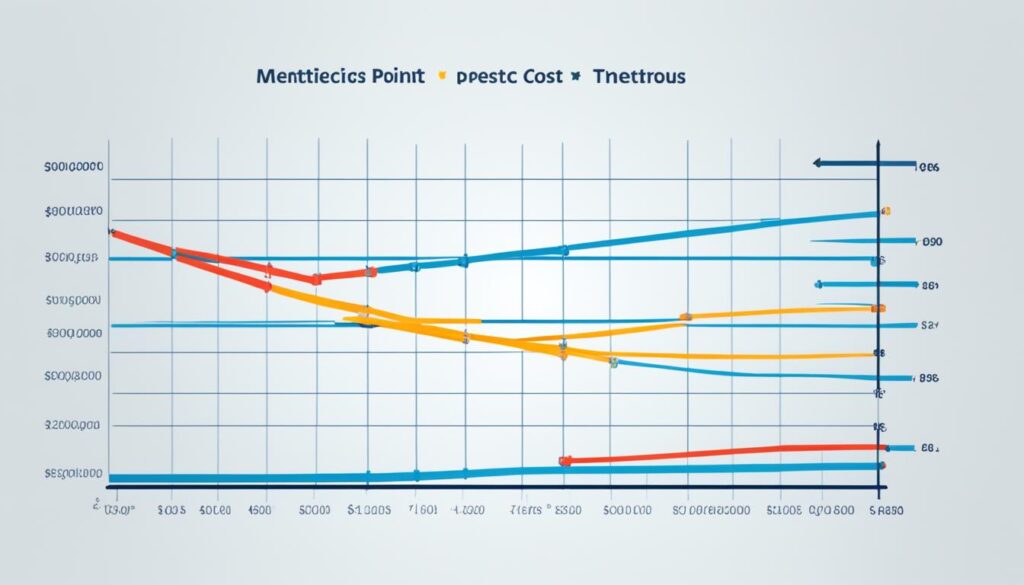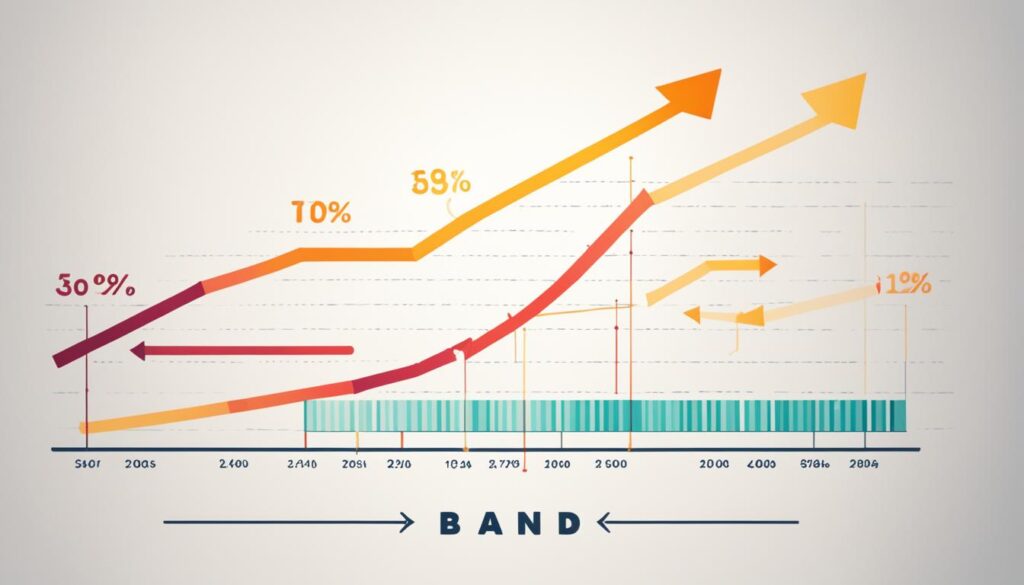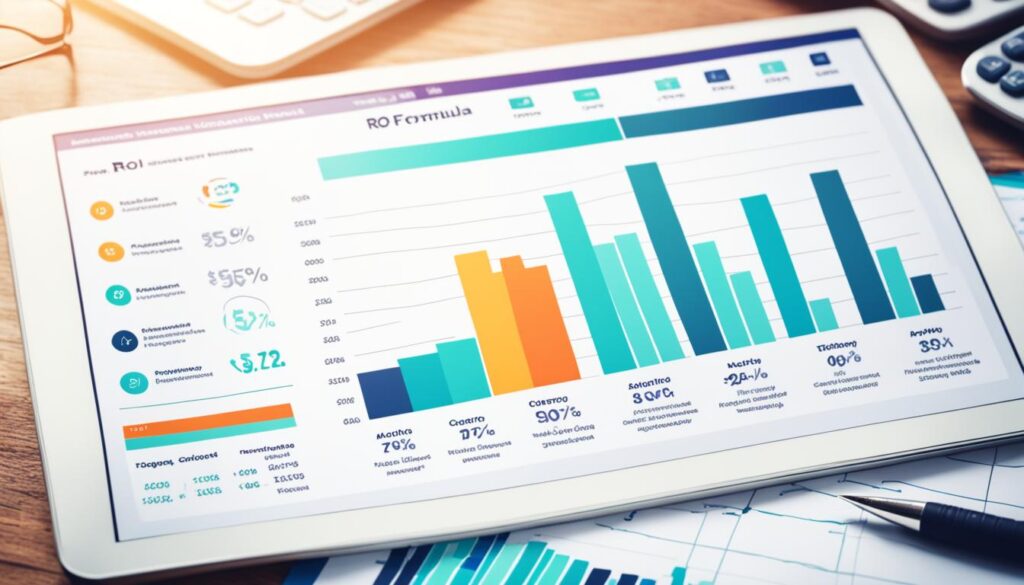Measuring the ROI of TV spokesperson marketing is vital for media sales experts. But how do you accurately measure the success and profit of TV ad campaigns with spokespersons? It’s about knowing the key metrics and analytics that show how well these campaigns are doing.
To figure out the ROI of your TV spokesperson marketing, several strategies and tools are helpful. These include looking at the reach and frequency of ads, the cost per point, and the cost per thousand. It also involves using metrics for attribution and conversion, as well as assessing brand lift and sentiment.
In this article, we explore crucial measurement techniques and analytics to evaluate TV spokesperson marketing success. Learn how these metrics reveal the impact of TV ads on sales, brand awareness, and customer behavior. Are you ready to learn how to maximize the ROI of your TV spokesperson campaigns?

Key Takeaways:
- Measuring the ROI of TV spokesperson marketing is crucial for media sales professionals
- Key metrics such as reach and frequency, cost per point, attribution and conversion, brand lift and sentiment, and the ROI formula and ratio provide valuable insights
- Calculating the ROI involves considering factors like reach, cost, brand impact, and customer behavior
- Various tools and techniques can help attribute sales and assess the effectiveness of TV spokesperson marketing
- By understanding these key metrics, media sales professionals can enhance the performance and profitability of TV spokesperson campaigns
Reach and Frequency: Estimating Exposure and Awareness
Measuring the ROI of a TV ad campaign needs looking at reach and frequency. Reach is how many different people saw the ad once. Frequency is how often someone sees the ad.
To figure out reach and frequency, we use ratings, impressions, and GRPs. Ratings show the percentage of a targeted audience that watched the ad. This tells us how popular the ad was with its intended viewers. Impressions count how many times the ad was seen, showing its overall reach.
GRPs are found by multiplying ratings by frequency. They measure the ad’s reach and how often it’s seen. GRPs help advertisers know how much exposure and awareness their TV ads might get.
“Reach and frequency are essential metrics for measuring the ROI of a TV ad campaign. Calculating these metrics helps estimate the potential exposure and awareness of TV ads among the target audience.”
Cost per Point and Cost per Thousand: Evaluating Efficiency and Affordability
Evaluating the efficiency and affordability of TV ad campaigns is vital. It helps measure the ROI. Cost per point (CPP) and cost per thousand (CPM) are two key metrics for this.
The cost per point shows how much you pay for one rating point. The cost per thousand shows the cost for one thousand impressions. These help understand how effectively and affordably ads reach the audience.
To figure out CPP and CPM, you need the ad’s cost and its ratings or impressions. CPP is the ad cost divided by rating points it got. CPM is the ad cost divided by impressions, counted in thousands.
By looking at CPP and CPM of different campaigns, advertisers can decide which are most efficient and affordable. Lower CPP and CPM mean more efficiency and affordability.
“Measuring CPP and CPM helps advertisers see how well their TV ads reach their audience. It shows how cost-effective the ads are given their budget and goals.”
Understanding CPP and CPM is key for making TV ad campaigns cost-effective. Evaluating these metrics allows advertisers to make smart decisions. This helps them use their ad budget well and increase their TV marketing’s ROI.
Example Table: Comparing CPP and CPM of Different TV Ad Campaigns
| Ad Campaign | Campaign Cost | Total Rating Points | CPP | Total Impressions (in thousands) | CPM |
|---|---|---|---|---|---|
| Campaign A | $50,000 | 500 | $100 | 1,000 | $50 |
| Campaign B | $75,000 | 1,000 | $75 | 2,000 | $37.50 |
| Campaign C | $100,000 | 1,200 | $83.33 | 2,500 | $40 |

Attribution and Conversion: Linking Behavior to TV Ads
In addition to reach and frequency, the tracking of attribution and conversion is key. It lets us see the true value of TV ads. Attribution helps assign credit to the right ads or channels. This shows us what leads to a customer deciding to buy. Conversion looks at what actions customers take after seeing TV ads. Did they buy something, visit our website, or interact with our brand?
To measure these accurately, marketers use several tools and methods:
- Web analytics: With these platforms, we can see how customers act on our site. This shows how TV ads affect visits, buys, and engagement.
- Call tracking: Call tracking lets us connect phone calls to specific ads. This way, we can see how TV ads influence customer calls and buys.
- Coupon codes: Using unique codes in ads helps track their use. This gives us clear data on how these ads drive sales.
- Surveys: Surveys collect feedback on how ads influenced buying. They highlight what parts of the ad caught the audience’s attention.
- Third-party platforms: Partnering with these platforms offers stronger data. They use complex algorithms to accurately measure our TV ads’ success.
By using these tools, we get a clearer picture of how TV ads affect customer actions. This knowledge helps us make our TV ads better, increase ROI, and grow our business.

Brand Lift and Sentiment: Assessing Impact on Brand Image
Measuring the ROI of a TV ad is not just about numbers. It also includes intangible aspects that affect how people see the brand. Brand lift and sentiment analysis are key in seeing how TV spokespersons change the brand image.
Brand lift shows the increase in brand awareness, recall, preference, or intent because of the TV ads. It checks if the ads have positively impacted the audience and boosted the brand. This helps media professionals know if the TV campaign pushed customers towards desired actions.
Sentiment analysis looks at the emotional response from the audience towards the TV ads. It tells us how people feel about the brand and their emotions about the campaign. Knowing this helps make sure the ads connect well emotionally and leave a good impression.
Various methods like surveys, interviews, and focus groups are used to measure brand lift and sentiment. These tools collect audience feedback on their views and feelings about the brand. Social media also helps in analyzing the public sentiment by looking at posts and interactions. This gives media experts insight into how the TV ads are perceived online.

Using brand lift and sentiment analysis helps media sales pros see the full effect of their TV campaigns. This approach makes planning and improving future TV ads better, aiming at stronger branding.
ROI Formula and Ratio: Quantifying the Return and Value
When measuring the ROI of a TV ad campaign, use the ROI formula and ratio. These tools let you precisely measure your marketing effort’s return and value. The ROI formula shows the campaign’s net profit versus its costs.
To calculate ROI, you need to look at different factors. These include product margin, customer lifetime value, and the cost of opportunities. Net profit is what you earn from the campaign after all costs. This includes making the ads, buying media space, and other direct costs. By finding the difference between revenue and costs, you get the net profit.
Ad costs are a big part of the ROI calculation. This covers everything spent on the campaign, like buying media space, making the ads, and distributing them. By comparing the net profit to the total cost, you can see if the campaign was worth it.
The ROI ratio is another important figure. It turns the ROI formula into a percentage to show how efficient the campaign was. By looking at the ROI ratios of different campaigns, you can find out which ones gave the best returns.
In the end, the ROI formula and ratio shed light on how well your TV ad campaign did. They help you make choices based on data, fine-tune your marketing, and use your resources wisely. With these tools, you can make sure your TV ads achieve what you want them to.

Note: The image above visualizes the process of quantifying the return and value of a TV ad campaign using the ROI formula and ratio.
Using Gross Sales, Effectiveness, Website Traffic, Customer Survey, and Promo Codes for ROI Calculation
To figure out the return on investment (ROI) for TV ads, several metrics are used. Gross sales, effectiveness, website traffic, customer surveys, and promo codes help gauge TV ads’ impact. They show if the ads are profitable.
Gross sales is a critical metric. It looks at sales increases from the ads. This metric shows how well the ads push product purchases and make money.
How well did the ad work? That’s what effectiveness evaluation looks at. It sees if the ad made people interested in a deal or product. It checks what viewers do after seeing the ad. This helps marketers improve future TV ads.
Website traffic is also important. It checks if more people visit the site after the ad airs. This shows if the ad captured viewers’ interest and brought them online. It’s a way to see if the TV ad worked to drive people to the website.
Customer surveys are key for linking the ad to sales and brand awareness. By asking customers how they heard about the product, marketers learn how much the TV ad influenced them. This gives insights into the ad’s reach and power.
Promo codes and unique phone numbers in the ad help track responses. They let marketers link sales directly to the TV ad. This helps calculate the ROI accurately. It shows how well the ad spurred action from viewers.
Using all these methods gives marketers a full picture of their TV ad’s ROI. Mixing gross sales, effectiveness, website traffic, customer surveys, and promo codes makes for a precise assessment. It helps in fine-tuning marketing strategies.
Now let’s dive deeper into calculating TV ad campaigns’ ROI with these metrics and tools.

| Metric | Description |
|---|---|
| Gross Sales | The increase in sales attributed to the TV ad campaign. |
| Effectiveness Evaluation | Analyzing how the ad promotes a deal or unique product and tracking customer actions. |
| Website Traffic Analysis | Monitoring the increase in website traffic during the airing of the TV ad. |
| Customer Survey Attribution | Directly asking customers where they heard about the business or product. |
| Promo Codes Tracking | Encouraging customers to use unique promo codes or dedicated phone numbers. |
Video ROI Calculation: Metrics, Formula, and Determining True ROI
Measuring the ROI of your video ad campaign is crucial. It involves looking at campaign costs and setting a time to check results. This gives deep insights into your campaign’s real impact. To get the video ROI, focus on the main metrics and use a proper formula.
Gross sales from your video ads are key to measure. They show how your campaign boosts sales. Looking at website traffic, survey answers, and promo code uses also helps understand your video’s ROI.
To find the final ROI, use a special formula. It multiplies a new customer’s average lifetime value by the total new customers. This tells you if your investment’s return beats the costs of making and showing your ad.
Improving your video ROI might need some changes. You can work on creative details, aim for different groups, and tweak your strategy. This can make your video ad campaign’s ROI better.
Calculating video ROI is complex and needs clear goals and objectives. Use the right metrics, a solid formula, and keep refining your approach. This way, you’ll know the true ROI of your video ads.

By measuring and analyzing carefully, you ensure your video marketing works well. It should not just bring results but also a good return on investment.
Challenges in Determining ROI of Video Campaigns: Multi-Channel Attribution, Delayed Impact, Emotional and Brand Impact
Figuring out the ROI of video campaigns is tricky. This is because of the complexity of multi-channel attribution, delayed impacts, and measuring emotional and brand impact. These elements make it hard to accurately measure the return on investment for video ads.
One big hurdle is multi-channel attribution complexity. With so many media platforms, consumers see ads in many places before buying. It’s hard to tell which ad led to a purchase. Marketers use advanced analytics and models to get it right. They look at how each touchpoint affects the customer journey.
Video ads also have a delayed impact. They can affect consumers long after they first see the ad. It’s tough to say when an ad influenced a purchase. This is true when an ad boosts brand recognition over time. Marketers use special tracking and analytics tools to understand these long-term effects.
Measuring emotional and brand impact is another challenge. Video ads can stir emotions and shape how people see a brand. But it’s hard to measure these effects in terms of ROI. Tools like surveys, interviews, and sentiment analysis help. They provide insights into how an ad impacts consumer behavior and brand perception.
To tackle these challenges, marketers need to blend technology with smart measurement methods. They also need to use digital analytics insights to fully understand campaign effectiveness. By using advanced models, tracking methods, and measuring emotional and brand impact, marketers can better understand their video ad campaigns’ ROI.

Tips to Improve the ROI of Television Ads: Knowing the Target Audience, Strong Call to Action, Emotional Connections, Being Updated and Relevant
Getting more from TV ads means really knowing your audience. Find out who they are to connect better. Look into their likes, dislikes, and what they care about. This way, your ads will speak directly to them.
A clear call to action is key for good results. It could be asking them to visit a site or call a number. Make this call to action stand out and easy to understand. This removes any confusion and gets them to act.
To build a strong bond with viewers, make your ads touch their emotions. Share stories and faces they can relate to. Add visuals that leave a mark. This way, they’ll remember and trust your brand more.
In the fast-paced ad world, staying current is crucial. Keep an eye on the latest trends and what people are into. Use new tech to spread your message wider. By keeping your ads fresh and relevant, you’ll boost their impact and your returns.